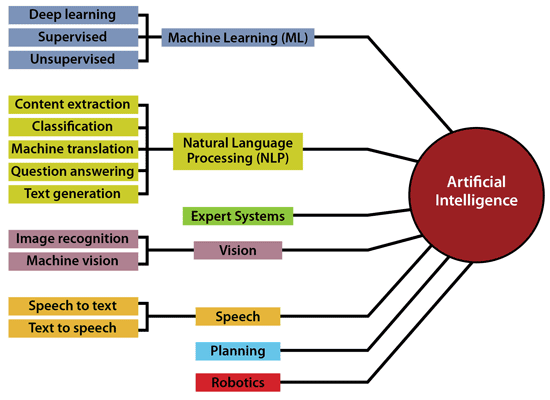While examples of artificial intelligence are numerous across business, AI is still often perceived to be a nascent, still emerging force.
In fact, AI is widely deployed. It is critical to the tech platforms of many businesses, across finance and retail and healthcare and media. AI and deep learning examples are so myriad, in fact, that choosing the representative AI example below was a matter of picking among the excess.

While the examples of AI below are very different from one another, they all share one common trait: the more data they are fed, the more they learn. That’s the very essence of artificial intelligence: a software system that learns based on input. That’s the key difference between Big Data analytics and AI: Big Data can scan data and reveal trends, but AI can do this and also adapt in response to input.

Examples of AI: AI Across Sectors
The following example of artificial intelligence are leading the market – companies adopting AI in the years ahead will likely look to the examples below.
Siri and Alexa
The challenge with voice-activated assistants – which play an ever growing role in business – is that they need to actually understand human speech. Even harder: they need to actually understand humans.
That’s where AI comes in. While the system engineers can build these voice assistants, they can’t embed the vast amount of human idiosyncrasy into them at launch. So these systems make heavy use of machine learning to enable them to get better and better at the exceptionally complex task of human-to-machine interface.
Armed with AI, voice assistants will grow ever more capable of scouring the web, helping us shop, providing directions. There’s an expectation that this voice technology will power in-home assistants to help care for the elderly, which is among countless other examples of AI voice recognition.
Amazon and Online Commerce
The concept of a system that responds to customer input isn’t by itself an example of artificial intelligence. For example, those ads for shirts that follow you around the Internet after you’ve casually checked out shirts aren’t necessarily an advanced AI application.
But in the case of Amazon’s recommendation system, it’s a powerhouse of a transactional AI platform. You have likely observed its ability to learn – and keep learning – season after season. In essence, hordes of shoppers are “teaching” the Amazon AI system to better display likely items for sale. That is, to match one item with another that the past has shown will prompt a sale. And to link semi-related concepts (like, say, light stands with photographic equipment).
On a related note, this kind of cutting edge AI system needs a vast computing platform to process all that data. You don’t power a system like that with a small server farm. Clearly, Amazon Web Services has at its disposal a world-leading computing platform.
Pandora
For those who say that AI will replace humans, Pandora’s AI system is an example of a system working with the humans. To start, Pandora employs musically-astute humans to analyze and categorize a song. Pandora looks at some 450 attributes of a song, from vocal style to rhythmic feel.
As the AI algorithm works, it incorporates countless recommendations from users, based on a body of user response to its song library. The AI system can then group and present songs in batches that make sense to masses of users – users who grew up with that style, in many cases.
Cogito
It is certainly one of the most active areas of artificial intelligence: using AI to enhance the emotional connection with customers in sales and customer service calls. Specifically, using AI to make an interaction more empathetic than humans alone would make it. To be sure, that’s a final frontier of AI usage.
Cogito (Latin for “I think”) uses a key truth of human interaction: it’s not just the words that deploy meaning, it’s the way those words are spoken, the mood, tempo, the feel of them.
Cogito software analyzes a conversation in real time, providing clues and prompts about what’s going right and wrong. Perhaps a speaker is cutting in too much, or holding forth too long, or not responding quickly enough. The application provides color-based warning and updates. The software analyzes hundreds of cues to determine the emotional quality of the conversation.
What’s next? Software falling on love with you? (See the movie Her.)
Nest
One of the key factors driving the growth of AI is the competition among deep-pocketed vendors to gain market share in these early days. In the case of home thermostat Nest, owned by Google, part of the goal is build Google’s AI into the device – helping push back against the encroaching growth of Apple’s Siri and Amazon’s Alexa.
Nest uses AI to adopt to human behavior patterns, getting constant input clues and responding more accurately as it lives in the home. Home owners make set the system manually for a period, then Nest incorporates input on its own.
In any case, smart home devices (a device connected to the Internet) are surely the key battleground in the battle for dominance of the AI market. Getting an entire group of smart home devices to act in concert – responding to the family, learning based on user behavior – is clearly the future of AI in the home front.
Boxever
Selling what it calls a ‘personalization platform,’ Ireland-based Boxever targets the travel industry. Its cloud-based platform allows travel companies to create a single customer view that enables more effective marketing to that customer. Its goal is to improve the sales process by targeting customers individually. If AI can customize an interaction on a one-on-one basis, in theory it can more capably serve (and sell to) that customer.
Boxever’s approach acknowledges that the key sector to compete in is customer experience. If a retailer wins that battle – by more carefully catering to an individual’s wants and needs – it wins the e-commerce war. And it is far cheaper to do this with intelligent software than human sales reps.
AI Robotics, Humanoid and Otherwise
AI powers countless robots, including UC Berkely’s BRETT and the infamous MIT dog. An example of an AI-powered robot that’s gained media buzz is Sophia, who chatted and sang (albeit rather robotically) with Jimmy Fallon on The Tonight Show.
Apart from the pop culture buzz, smart AI robots come in a multitude of shapes and sizes. IRobot’s Roomba 980 vacuum cleaner employs AI to get a sense of the room it will be hovering up, from size to most efficient pattern to sweep the space. Let it go and it does all the work. The company claims that in excess of 10 million Roombas have been sold.
Spam Filters
At the core of AI is the concept of learning. Using machine learning and other AI technologies, a software system gets smarter and smarter, without human assistance.
Certainly fighting spam is an area where machine learning is desperately needed. No human (or even team of humans) could keep up with the torrent of spam. Gmail, for instance, deploys ML algorithms to filter (most of) the spam.
To do this, the spam filter tries to work faster (or at least keep up with) the spammers, who are constantly coming up with new and creative ways to cheat humans. The AI in the spam filter continuously scans for metadata, such as location of the sender or keywords in the subject line. If it can’t learn, a spam filter can’t function more than a few days.
Part of the AI technology is using inputs from humans: One user’s valuable coupon is another user’s spam. How that particular user categorizes a stream of mail must be part of the spam filter’s learning.
Online Banking
Your bank makes you a convenient offer: scan your check and deposit it with your mobile device. No need to visit the actual branch office. The problem: doing so requires a machine to read human hand writing, which is a messy and confusing endeavor – even for humans.
Among other vendors, Mitek Systems specializes in software-based identity verification. It’s AI technology uses computer vision and machine learning to make mobile-to-bank transactions safe (or at least safer).
Mitek, for instance, employs a vision algorithm to classify countless ID formats in banking transactions. Core to this is Optical Character Recognition (OCR) software that scans documents and converts that data into a editable format. The OCR software can be adjusted with AI to accurately extract personal signifiers.
Loan and Credit Card Processing
Your FICO score (usually between 300 to 850) rules your world, or it does when you’re applying for a credit card or a loan. In the old days, human loan officers reviewed all those loan and credit card applications. While there are still plenty of human loan officers, many decisions about credit cards – to accept a consumer’s application or not – are made by a machine learning system.
Again, learning is a core part of this process. Bank management – actual humans – can set parameters of who loose or tight they want current credit standards to be. But they want their bank’s machine learning system to learn over time, to more closely identify which applicants are safe borrowers.
Lyft and Uber
The world of ride sharing could not exist without AI and machine learning. Specifically, the price of the fare, the estimated arrival time, and the route it will take: these are all figured out by AI.
AI makes a vast number of computations on the fly; the amount and complexity of these computations would be impossible without an ML system that analyzed the situation, and then routes the resulting data to users’ and drivers’ apps. (And of course records it on the company own system; both Lyft and Uber possess an ocean of data about user patterns.)
In the future, these services foresee a period of driverless cars (though when this will happen remains vague at best). Without the element of a human driver, the process of running the system becomes a more purely logical machine learning computation. In theory this would cause the ride sharing services’ costs to fall, even beyond the savings from not needing drivers.
Social Networks
The major social media networks are a core driver of the development of artificial intelligence. Facebook in particular seemingly uses every aspect of AI. For instance, its algorithm defines your timeline, deciding to show or not show certain of your friends’ posts on your timeline. Facebook knows that if everyone of your friends was displayed, your timeline would be so cluttered it would be off-putting. So the timeline algorithm learns who you interact with and who you normally ignore. (So if you want to see more of a friend’s posts, you might want to actually Like it).
Most important (to Facebook’s bottom line), the social network uses AI to help personalize the way it feeds you ads, so it has some measure of relevancy for its ad display. Notice that Facebook allows you to comment on an ad’s relevancy to your timeline; every user comment helps the system learn and become more finely tuned. Facebook and Google have a remarkably high percent of the total online ad market, because of the way they use AI to fine tune the display system.
Also, Facebook uses image recognition AI technology to identify the faces in a photo, so it can invite you to tag it. Not surprisingly, given how important photos are to Facebook, the company has invested heavily in facial recognition technology. That a machine can “read” a photograph is one of the more remarkable advances in the current era of artificial intelligence.
SEE ALL
ARTIFICIAL INTELLIGENCE ARTICLES 










